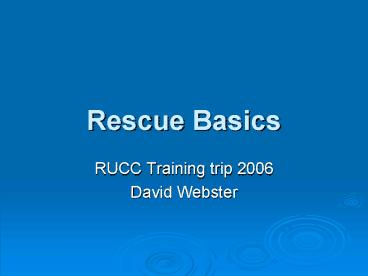Rescue Basics - PowerPoint PPT Presentation
1 / 16
Title:
Rescue Basics
Description:
Rescue Basics. RUCC Training trip 2006. David ... Principle of Personal Safety. You should not take unnecessary or unjustifiable risks: ... Training Courses ... – PowerPoint PPT presentation
Number of Views:92
Avg rating:3.0/5.0
Title: Rescue Basics
1
Rescue Basics
- RUCC Training trip 2006
- David Webster
2
Rescue Principles
- Principle of Personal Safety
- Look after yourself youre worse than useless
- if you become a victim too!
- Principle of Victims Best Interest
- Dont make the situation worse.
- Principle of Simplicity
- Keep it simple, keep it fast.
- Principle of Maximum Usefulness
- Place yourself where youre going to be most
useful - Principle of the Clean Line
- Ropes are dangerous around water
- Principle of Presumed Insanity
- The assumption must be that the victim is a
- homicidal maniac whose only mission in life is
- to drown you
3
Principle of Personal Safety
- You should not take unnecessary or unjustifiable
risks - Its not good for you
- The situation will escalate
- Additional rescuers will be required
- Your victim wont get saved any quicker
- You wont get to the pub as quickly
- NOTE Can be difficult on a river, because the
victim is often your friend
4
Principle of Victims Best Interest
- No action by rescuers should place victims in
more danger than they were already in - Theres no point in making the situation worse
- The victim wont thank you for it
- You have a duty of care to the victim
5
Principle of Simplicity
- Keep it simple, keep it fast
- Simple solutions are quicker to implement
- There is less to go wrong
- Other people will understand them easier
- They require less additional equipment
- They tend to be more flexible
6
Principle of Maximum Usefulness
- As a rescuer you should always be where youll be
needed the most - This applies while paddling down the river as
well as in rescue situations - Where youre needed most will change so your
position should be as flexible as possible
7
Principle of the Clean Line
- Ropes and water are a bad mix
- Knots, or handles or other things attached to
ropes tend to get hooked up on a river - If they get hooked up or caught on rocks in a
current, the object on the other end (possibly
the victim) will drift towards the bottom of the
river
8
What rescue kit would/should you have available
on a river?
9
Rescue kit available
- ? Yourself
- ? Other people
- ? Paddle
- ? Boat
- ? Throwline
- ? Sling
- ? Carabiners
- ? Whistle
- ? Knife
- Rescue Harness
- Anything else that might be useful
10
In a rescue situation, you need to
- 1. Assess the situation
- 2. Stabilise the situation
- 3. Reassess the situation
- 4. Decide on a plan of action
- 5. Communicate plan to team
- 6. Allocate tasks and ensure everyone understands
- 7. Execute plan
- 8. Review incident
11
Protecting a rapid
- aka setting up safety
12
Why set up safety?
13
Why set up safety?
- The aim of setting up safety is to
- Anticipate if a rescue is required
- Put people in place to carry out that rescue
- This will make a rescue
- Quicker
- Safer
- More capable
14
How to protect a rapid
15
Where to get more information
- Books
- Franco Ferrero White Water Safety and Rescue
- Lots of others
- Experience
- You cant do without it - get out there and get
some
- Training Courses
- White Water Safety and Rescue (BCU) - the club
will organise one - try and go on it - Swiftwater Safety and Rescue (Rescue 3) - More
advanced than WWSR, aimed at professional
rescuers
16
(No Transcript)































